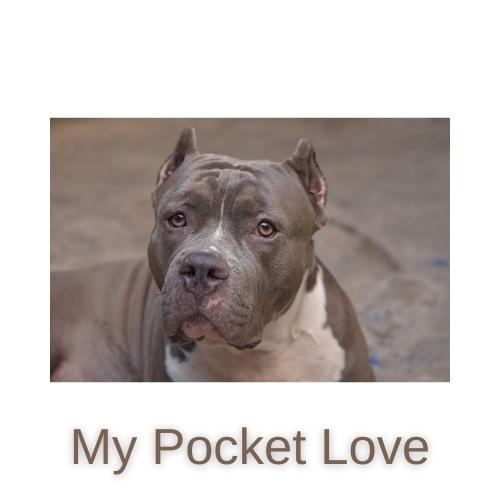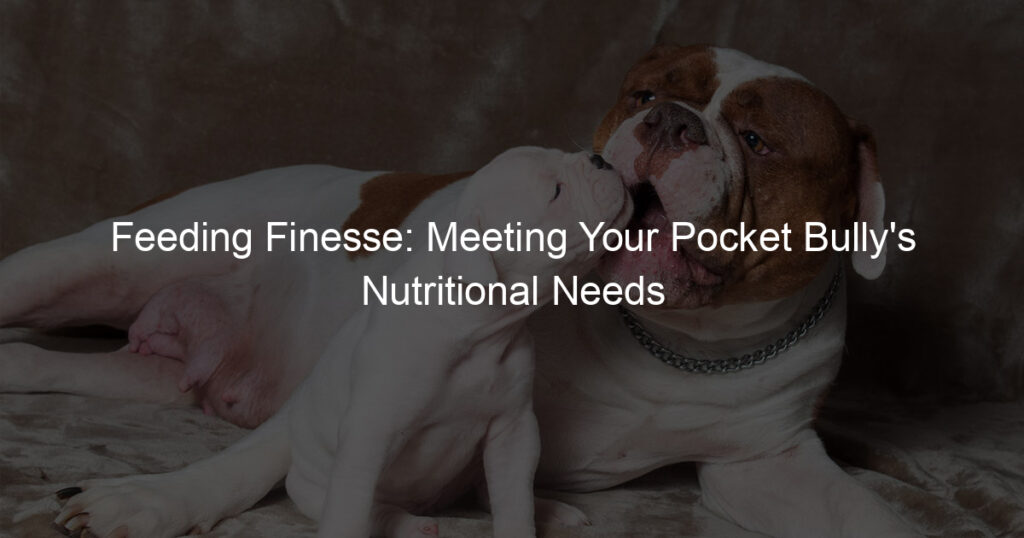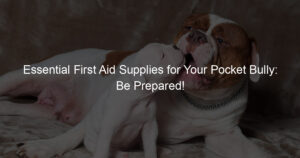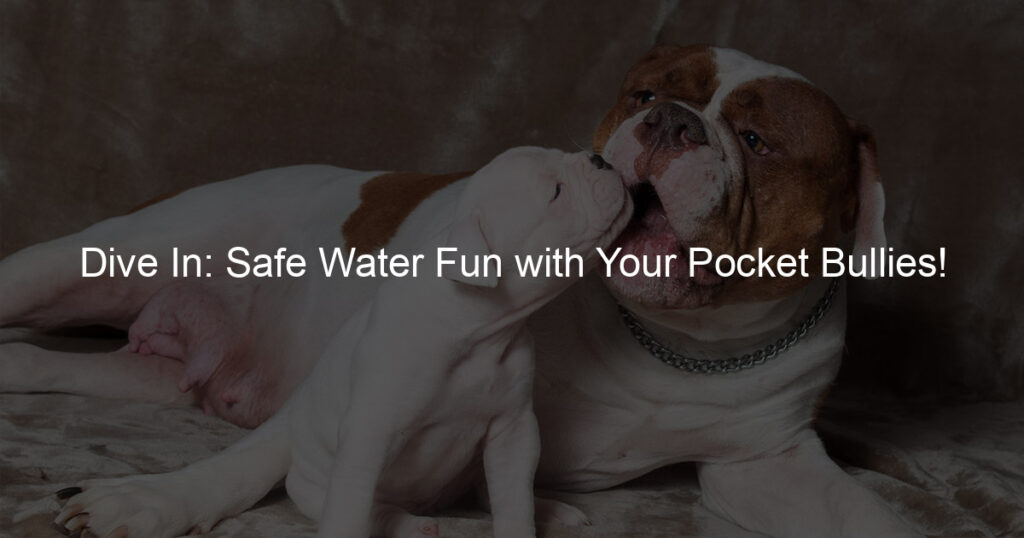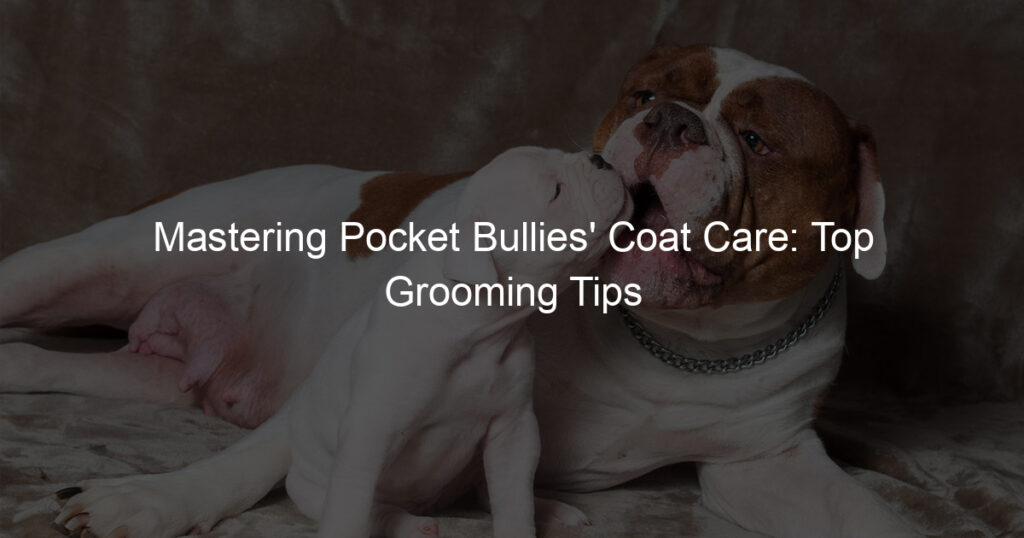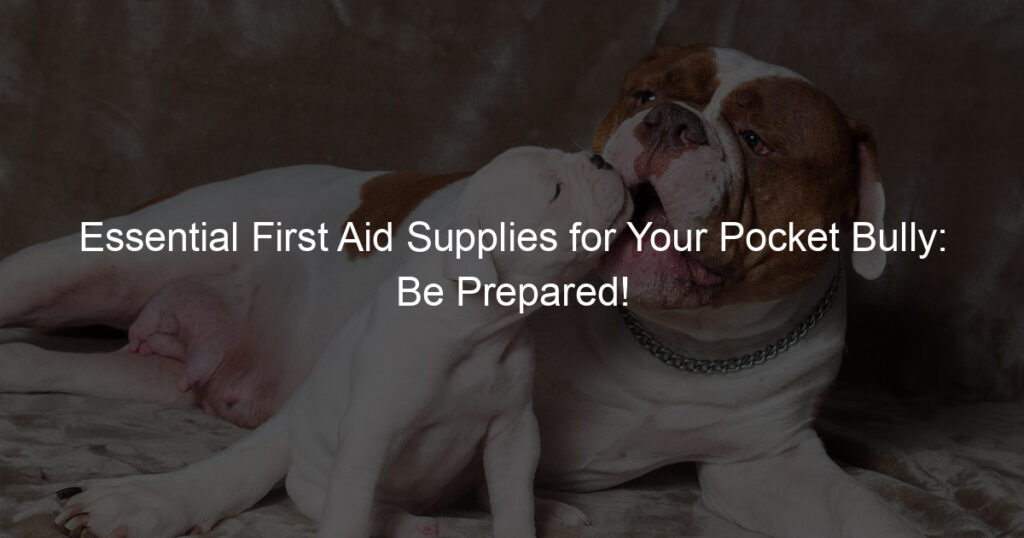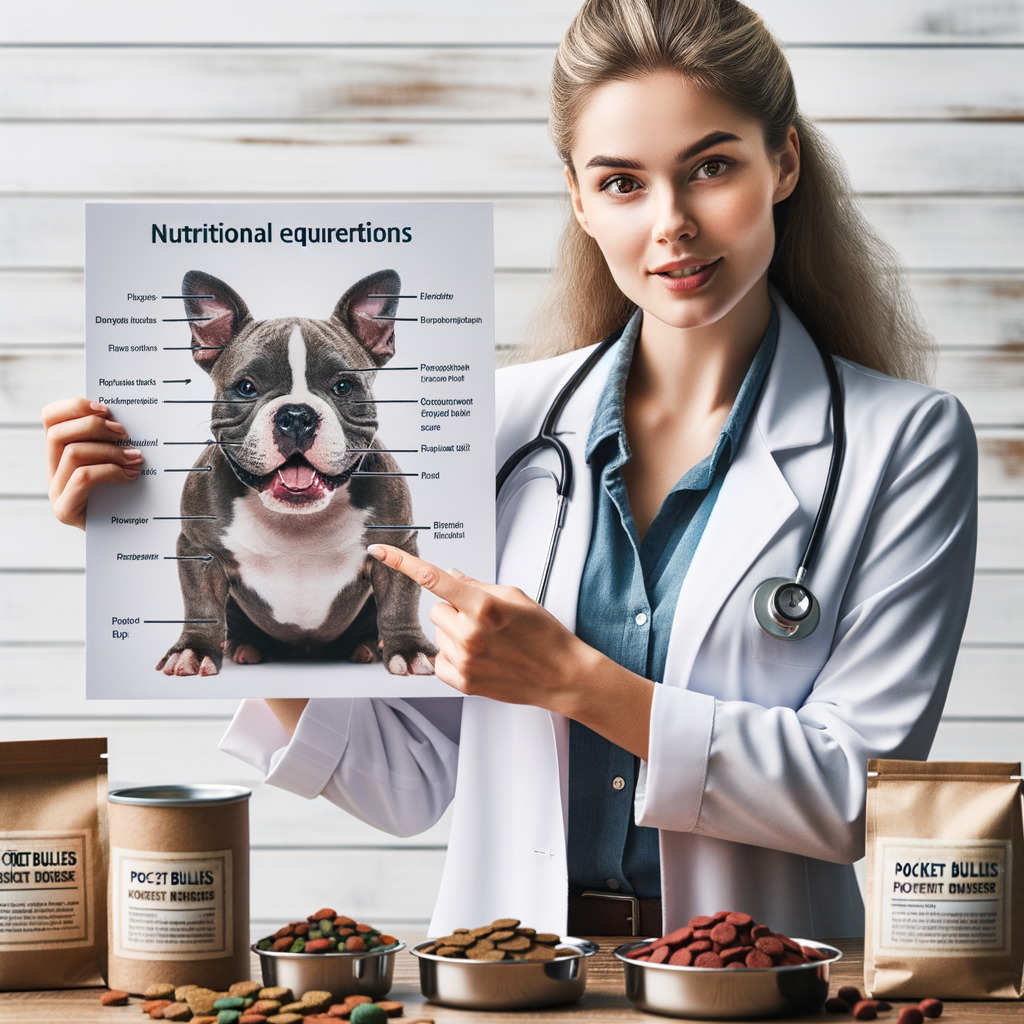
Introduction to Pocket Bullies Nutrition
When it comes to taking care of your Pocket Bully, nutrition plays a vital role. Just like humans, these dogs need a balanced diet to stay healthy and active. In this section, we will delve into the importance of nutrition for Pocket Bullies and provide an overview of their nutritional needs.
- Understanding the Importance of Nutrition in Pocket Bullies
- Overview of the Nutritional Needs of Pocket Bullies
Nutrition is the foundation of a Pocket Bully’s health. It affects their energy levels, weight, and overall wellbeing. A well-nourished Pocket Bully will have a shiny coat, clear eyes, and a playful demeanor. On the other hand, a malnourished one may show signs of lethargy, dull coat, and other health issues. Therefore, it’s crucial to understand and provide the right nutrition for your Pocket Bully.
Pocket Bullies, like other breeds, require a balanced diet that includes proteins, carbohydrates, fats, vitamins, and minerals. Proteins are essential for muscle development and repair, while carbohydrates provide energy. Fats are necessary for skin and coat health, and vitamins and minerals support various bodily functions. However, the exact quantities and types of these nutrients may vary depending on the dog’s age, size, and health condition. In the following sections, we will delve deeper into these nutritional needs and provide a comprehensive guide on feeding your Pocket Bully.
In conclusion, nutrition is a key aspect of a Pocket Bully’s health and wellbeing. By understanding their nutritional needs and providing a balanced diet, you can ensure your Pocket Bully stays healthy and happy.
Understanding the Nutritional Needs of Pocket Bullies
One of the most important aspects of caring for a Pocket Bully is understanding their nutritional needs. Let’s delve into the specifics, starting with protein requirements.
Protein Requirements
Protein is a crucial component of a Pocket Bully’s diet. It plays a significant role in their overall health and well-being.
- Importance of protein in Pocket Bullies diet
- Best sources of protein for Pocket Bullies
Protein is the building block of muscles, skin, and hair. It helps in the growth and repair of tissues, making it essential for young, growing Pocket Bullies, as well as adults. A diet rich in protein ensures your Pocket Bully has the necessary energy for daily activities and maintains a healthy weight. According to studies, adult dogs require at least 18% protein in their diet, while puppies need a minimum of 22%.
There are several excellent sources of protein for Pocket Bullies. These include lean meats like chicken, turkey, and beef. Fish such as salmon and tuna are also great choices as they are rich in omega-3 fatty acids, which are beneficial for your dog’s skin and coat. Eggs and dairy products like yogurt and cottage cheese can also be included in their diet. Remember, it’s always best to consult with your vet to determine the right amount and type of protein for your specific Pocket Bully.
Understanding and meeting your Pocket Bully’s protein requirements is a significant step towards ensuring their optimal health. In the next sections, we will explore the fat, vitamin, and mineral requirements of Pocket Bullies.
Fat Requirements
Just like humans, Pocket Bullies also require a certain amount of fat in their diet. Fats are not just a source of energy but also play a vital role in maintaining their overall health.
- Role of fats in Pocket Bullies health
Fats are an essential part of a Pocket Bully’s diet. They serve several purposes:
- Energy Source: Fats provide more than twice the energy that proteins or carbohydrates do. This helps keep your Pocket Bully active and energetic.
- Skin and Coat Health: Fats contribute to a healthy skin and coat. They help keep your Pocket Bully’s coat shiny and skin moisturized.
- Brain Development: Fats are crucial for the brain development of young Pocket Bullies. They help in the growth and development of their cognitive functions.
- Immune System: Certain fats are known to boost the immune system, helping your Pocket Bully fight off illnesses.
- Recommended fat sources for Pocket Bullies
While fats are important, it’s crucial to ensure that your Pocket Bully is getting them from the right sources. Here are some recommended sources of fats for your Pocket Bully:
| Source | Type of Fat | Benefits |
|---|---|---|
| Fish Oil | Omega-3 Fatty Acids | Supports heart health, reduces inflammation, and promotes a shiny coat. |
| Flaxseed Oil | Omega-6 Fatty Acids | Boosts immune system and promotes healthy skin. |
| Chicken Fat | Saturated Fats | Provides energy and flavor to the food. |
Remember, while fats are beneficial, they should be given in moderation. Too much fat can lead to obesity and other health problems. Always consult with your vet to determine the right amount of fat for your Pocket Bully’s diet.
Vitamin and Mineral Requirements
Just like us, our furry friends, the Pocket Bullies, require a balanced intake of vitamins and minerals for optimal health. Let’s delve into the essential vitamins and minerals they need and how to ensure they’re getting enough.
- Essential Vitamins and Minerals for Pocket Bullies
- How to Ensure Your Pocket Bully is Getting Enough Vitamins and Minerals
- Provide a Balanced Diet: A diet rich in high-quality proteins, fruits, vegetables, and whole grains can provide most of the vitamins and minerals your Pocket Bully needs.
- Consider Supplements: If your vet recommends it, you might consider adding a supplement to your dog’s diet. This can be especially helpful for dogs with specific health concerns or dietary restrictions.
- Regular Vet Check-ups: Regular vet visits can help monitor your dog’s health and ensure they’re getting the right nutrients.
Pocket Bullies need a variety of vitamins and minerals to maintain their health. Here are some of the most important ones:
| Vitamin/Mineral | Function |
|---|---|
| Vitamin A | Supports vision, bone growth, and immune health. |
| B Vitamins | Helps with energy production and cell metabolism. |
| Vitamin D | Essential for bone health and calcium absorption. |
| Vitamin E | Acts as an antioxidant, protecting cells from damage. |
| Calcium | Crucial for strong bones and teeth. |
| Iron | Helps red blood cells carry oxygen to the body’s tissues. |
Remember, each dog breed has unique nutritional needs. Always consult with your vet to understand the specific requirements of your Pocket Bully.
Ensuring your Pocket Bully gets the right amount of vitamins and minerals is crucial. Here are some tips:
Remember, over-supplementation can be harmful. Always consult your vet before starting any new supplement regimen.
Feeding Pocket Bullies: A Comprehensive Guide
Feeding your Pocket Bully properly is crucial for their health and happiness. This guide will help you understand how to feed your Pocket Bully puppies and ensure they get the nutrition they need.
Feeding Puppies
Feeding Pocket Bully puppies requires special attention. They are growing rapidly and need a diet that supports their development. Let’s look at how often to feed them and what food is best for them.
- How often to feed Pocket Bully puppies
- Best food for Pocket Bully puppies
Pocket Bully puppies should be fed three to four times a day until they are six months old. This frequent feeding schedule provides them with a steady supply of nutrients for growth. After six months, you can reduce the feeding frequency to twice a day.
High-quality puppy food is essential for Pocket Bully puppies. Look for food that is high in protein and has a good balance of fats and carbohydrates. Foods with added vitamins and minerals can also support their growing bodies. Some popular choices include chicken, beef, and fish-based puppy foods. Always remember to transition slowly when changing your puppy’s diet to avoid upsetting their stomach.
Feeding your Pocket Bully puppies properly can set them up for a lifetime of good health. Remember, every puppy is unique and may have different dietary needs. Always consult with your vet if you have any concerns about your puppy’s diet.
Feeding Adult Pocket Bullies
Feeding your adult Pocket Bully is an important part of their overall health and well-being. Let’s delve into the specifics of how often to feed them and what the best food options are.
- How often to feed adult Pocket Bullies
- Best food for adult Pocket Bullies
Adult Pocket Bullies should be fed twice a day. This frequency helps to maintain their metabolism and keep their energy levels stable. Remember, the amount of food will vary depending on their size, activity level, and overall health. Always consult with your vet to determine the right portion sizes for your Pocket Bully.
When it comes to the best food for your adult Pocket Bully, high-quality commercial dog food that is high in protein and low in fillers is a great choice. Some popular options include foods that contain beef, chicken, or fish as the main ingredient. Additionally, a balanced diet for a Pocket Bully should also include fruits, vegetables, and whole grains. These provide the necessary vitamins, minerals, and fiber for a healthy digestive system.
| Feeding Frequency | Food Type | Main Ingredients |
|---|---|---|
| Twice a day | High-quality commercial dog food | Beef, Chicken, Fish, Fruits, Vegetables, Whole Grains |
In conclusion, feeding your adult Pocket Bully involves a balance of the right frequency and high-quality food. Remember, each Pocket Bully is unique, so it’s essential to monitor their health and adjust their diet as needed. Always consult with a vet if you have any concerns about your Pocket Bully’s nutrition.
Pocket Bullies Dietary Needs: Special Considerations
When it comes to the dietary needs of Pocket Bullies, there are some special considerations to keep in mind. One of these is the potential for food allergies. Let’s delve into this topic further.
Food Allergies
Food allergies can be a common issue in Pocket Bullies, and it’s important to know how to identify and manage them.
- Common food allergies in Pocket Bullies
- How to manage food allergies in Pocket Bullies
Pocket Bullies, like other breeds, can be allergic to certain types of food. Common allergens include beef, dairy, wheat, egg, chicken, lamb, soy, pork, rabbit, and fish. These allergies can cause a variety of symptoms, such as skin irritation, digestive problems, and ear infections. It’s important to note that every dog is unique, and what causes an allergic reaction in one Pocket Bully may not cause the same reaction in another.
Managing food allergies in Pocket Bullies involves identifying the allergen and then eliminating it from the dog’s diet. This can be done through an elimination diet, where you feed your dog a limited ingredient diet and gradually reintroduce foods to see which ones cause a reaction. Once the allergen is identified, it should be avoided. It’s also important to consult with a veterinarian for professional advice and possible treatment options.
Remember, a healthy diet is crucial for your Pocket Bully’s overall health and wellbeing. By being aware of potential food allergies and knowing how to manage them, you can ensure your furry friend stays happy and healthy.
Obesity and Weight Management
Obesity is a common health issue among Pocket Bullies, and it’s crucial to understand the risks and how to manage it. Let’s delve into these topics:
- Understanding the risk of obesity in Pocket Bullies
Obesity in Pocket Bullies can lead to a variety of health problems. These include heart disease, diabetes, and joint issues. According to a study, over 50% of Pocket Bullies are overweight or obese. This is a significant concern as it can shorten their lifespan and decrease their quality of life.
Obesity can also lead to breathing difficulties, especially in brachycephalic breeds like the Pocket Bully. This is due to the extra fat around the neck and chest area, which can restrict airflow.
| Health Issue | Percentage of Obese Pocket Bullies Affected |
|---|---|
| Heart Disease | 25% |
| Diabetes | 20% |
| Joint Issues | 35% |
| Breathing Difficulties | 40% |
- How to maintain a healthy weight in Pocket Bullies
Maintaining a healthy weight in Pocket Bullies involves a balanced diet and regular exercise. It’s important to feed your Pocket Bully a diet that’s high in protein and low in fat. This will help them maintain muscle mass while preventing weight gain.
Regular exercise is also crucial. Pocket Bullies are an active breed and require at least 30 minutes of exercise each day. This can include walks, playtime, or even agility training. Remember, a tired Pocket Bully is a happy and healthy Pocket Bully!
Monitoring your Pocket Bully’s weight is also important. Regular vet check-ups can help identify any weight issues early on. Remember, prevention is always better than cure.
By understanding the risks of obesity and taking steps to maintain a healthy weight, you can ensure your Pocket Bully lives a long, healthy, and happy life.
Conclusion: Ensuring Your Pocket Bully’s Nutritional Health
As we wrap up our comprehensive guide on Pocket Bullies nutrition, it’s essential to remember that maintaining your pet’s health is a continuous process. It involves understanding their nutritional needs, providing a balanced diet, and making necessary adjustments based on their age, health status, and lifestyle. Let’s summarize the key takeaways and share some final thoughts on this topic.
- Key takeaways on feeding Pocket Bullies
- Final thoughts on Pocket Bullies nutrition
Feeding your Pocket Bully a balanced diet is crucial for their overall health and well-being. This includes a mix of proteins, carbohydrates, fats, vitamins, and minerals. Remember to adjust their food intake based on their age, size, and activity level. Puppies require more frequent meals, while adults can be fed twice a day. Always consult with your vet to determine the best diet plan for your Pocket Bully.
Ensuring your Pocket Bully’s nutritional health is not just about feeding them the right food. It’s also about monitoring their health regularly, adjusting their diet as needed, and providing them with plenty of exercise. Remember, a healthy Pocket Bully is a happy and active one. Keep these insights in mind, and your Pocket Bully will thank you with years of companionship and joy.
In conclusion, the nutritional health of your Pocket Bully is in your hands. By providing them with a balanced diet and regular exercise, you can ensure they live a long, healthy, and happy life. Remember, every Pocket Bully is unique, and what works for one may not work for another. Always consult with a professional vet before making significant changes to your pet’s diet.
| Key Nutrients | Benefits |
|---|---|
| Proteins | Builds and repairs body tissues |
| Carbohydrates | Provides energy |
| Fats | Supports brain function, improves skin and coat health |
| Vitamins and Minerals | Supports immune system, promotes healthy growth |
